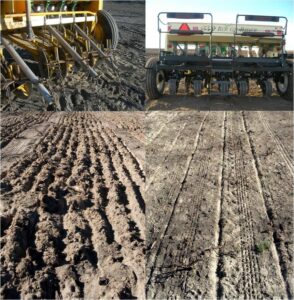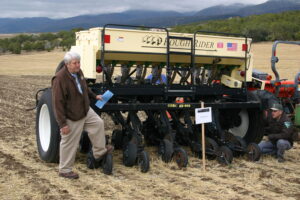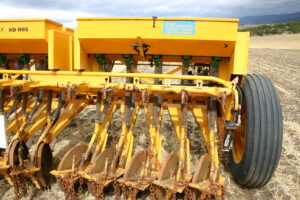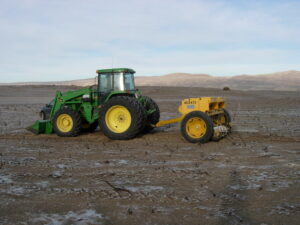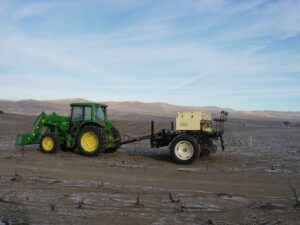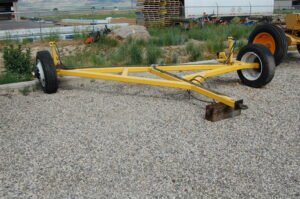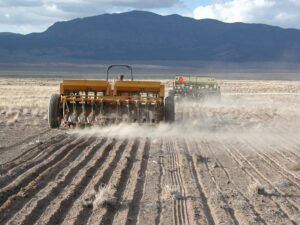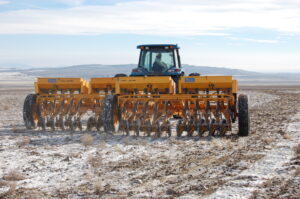Description
Grass drills and seeders consist of seed hoppers, metering devices, and some type of seed placement device. Grass drills range in width from 6 to 15 feet, while grain drills can be up to 40 feet wide. Row spacing varies between 8 and 12 inches, with 12 inches common for rangeland seeding. The metering systems have the capability to deliver 0.5 to 20 lbs of seed per acre. Drills use several different styles of ground-drives to power the metering system. Most drills are towed and use a hydraulic lift mechanism while some drills attach to the tractor’s 3-point hitch. No-till drills use coulters of various sizes and shapes to cut cover-crop residue ahead of the seed-furrow openers. Drills and seeders designed for rangeland are normally extra-heavy duty to withstand the rigors of rough-terrain. A minimum-till drill is available that can seed in rough, non-tilled soil with limited debris.
Application
Cropland drills are applicable for clean-tilled land and do not do well when rocks and debris are present. Rangeland drills are designed with a variety of options to overcome the rigor of rangeland conditions. Seed mixes are commonly used on rangeland. Chaffy and slick seed must be metered separately. Knowledge of the optimum seeding depth of the selected species is important to insure that the correct furrow openers, depth bands, press wheels, and covering devices are used.
Images
References / Additional Information
Asher, J.E.; Eckert, R.E. 1973. Development, testing, and evaluation of the deep furrow drill arm assembly for the rangeland drill. Rangeland Ecology and Management. 26(5): 377-379.
Doerr, T.B. 1986. Rangeland drill. Tech Report EL-86-41. Vicksburg, MI: U.S. Department of the Army, U.S. Army Corps of Engineers. 8 p.
Ott, J.E.; Cox, R.D.; Shaw, N.L. 2017. Comparison of postfire seeding practices for Wyoming big sagebrush. Rangeland Ecology and Management. 70: 625-632.
Ott, J.E.; Cox, R.D.; Shaw, N.L.; Newingham, B.A.; Ganguli, A.C.; Pellant, M.; Roundy, B.A.; Eggett, D.L. 2016. Postfire drill-seeding of Great Basin plants: Effects of contrasting drills on seeded and nonseeded species. Rangeland Ecology and Management. 69: 373-385.
Outka-Perkins, L. 2010. Video: Calibrating your rangeland drill. https://www.fs.usda.gov/t-d/library-card.php?p_num=1022%202D03
St. John, L.; Cornforth, B.; Simonson, B.; Ogle, D.; Tilley, D. 2008. Calibrating the Truax Rough Rider Seed Drill for restoration plantings. Tech Note 20. Boise, ID: USDA, Natural Resources Conservation Service. 15 p.
St. John, L.; Ogle, D.; Holzworth, L.; Stannard, M.; Cornwell, J. 2007. Calibrating a seed drill for conservation plantings. Tech Note 19. Boise, ID: USDA, Natural Resources Conservation Service. 15 p.
Stevens, R.; Monsen, S.B. 2004. Chapter 9. Mechanical plant control. In: Monsen, S.B.; Stevens, R.; Shaw, N.L., comps. Restoring western ranges and wildlands, vol. 1. Gen. Tech. Rep. RMRS-GTR-136-vol-1. Fort Collins, CO: U.S. Department of Agriculture, Forest Service, Rocky Mountain Research Station. p. 65-88.
Wiedemann, H.T.; Brock, J.H.; Fisher, C.E.; Cross, B.T. 1979. Seed metering and placement devices for rangeland seeders. Transactions of the American Society of Agriculture and Biological Engineers. 22(5): 1275-1278.


